-
PDF
- Split View
-
Views
-
Cite
Cite
Benjamin L'Huillier, Arman Shafieloo, Hyungjin Kim, Model-independent cosmological constraints from growth and expansion, Monthly Notices of the Royal Astronomical Society, Volume 476, Issue 3, May 2018, Pages 3263–3268, https://doi.org/10.1093/mnras/sty398
Close - Share Icon Share
Abstract
Reconstructing the expansion history of the Universe from Type Ia supernovae data, we fit the growth rate measurements and put model-independent constraints on some key cosmological parameters, namely, Ωm, γ, and σ8. The constraints are consistent with those from the concordance model within the framework of general relativity, but the current quality of the data is not sufficient to rule out modified gravity models. Adding the condition that dark energy density should be positive at all redshifts, independently of its equation of state, further constrains the parameters and interestingly supports the concordance model.
1 INTRODUCTION
The discovery of the acceleration of the expansion of the Universe (Riess et al. 1998; Perlmutter et al. 1999) led to the emergence of the Λ cold dark matter (ΛCDM) paradigm, further supported by the study of the cosmological microwave background (Bennett et al. 2003; Planck Collaboration XIII 2016) and the large-scale structures of the Universe (e.g. Eisenstein et al. 2005; Alam et al. 2017). In this paradigm, gravity is described by general relativity (GR), and the energy budget is dominated by the cosmological constant as dark energy (DE), responsible for the acceleration of the expansion, and a smooth, cold dark matter component. However, the nature of DE is one of the biggest mysteries of modern physics, and the simplest candidate, the cosmological constant, poses theoretical problems (e.g. Weinberg 1989; Peebles & Ratra 2003). Alternatively, GR may not be the correct theory to describe gravity, and the acceleration may reflect departure from GR.
From equations (4) and (5), it is clear that fσ8 depends on (Ωm, γ, σ8) and the expansion history h(z). In GR, γ ≃ 0.55, while modified theories of gravity such as f(R) (de Felice & Tsujikawa 2010) or DGP (Dvali, Gabadadze & Porrati 2000) predict different (possibly scale-dependent) values of γ (Linder & Cahn 2007). Therefore, fσ8 is a powerful probe of gravity. Moreover, joined measurements of h(z) and fσ8 can help break degeneracies between modified gravity theories and DE (Linder 2005, 2017). Therefore, it has been used to test the ΛCDM model or alternative gravity theories (e.g. Nesseris & Perivolaropoulos 2008; Bean & Tangmatitham 2010; Basilakos 2012; Shafieloo, Kim & Linder 2013; Gómez-Valent, Solà & Basilakos 2015; Ruiz & Huterer 2015; Mueller et al. 2016; Nesseris, Pantazis & Perivolaropoulos 2017; Solà, Gómez-Valent & de Cruz Pérez 2017).
In this paper, we aim to constrain some key cosmological parameters, namely, Ωm, σ8, and γ, by fitting the growth data using model-independent expansion histories that do not assume any DE model.
Section 2 describes the data and method, our results are shown in Section 3. Section 4 explores the effects of restricting the DE density to be positive at all redshift, and our conclusions are drawn in Section 5.
2 METHOD
We used reconstructed expansion histories from the Joint Light-curve Analysis (JLA; Betoule et al. 2014) and combined them with growth measurements.
2.1 Model-independent reconstructions of the expansion history
We should note that the method of smoothing we used in this work is in fact insensitive to the initial conditions and choice of the smoothing scale (cf. Shafieloo et al. 2006; Shafieloo 2007): whatever the initial conditions, the method converges to the solution preferred by the data. However, they will approach this final solution via different paths. The central idea of using the iterative smoothing in this work is to come with a non-exhaustive sample of plausible expansion histories of the Universe directly reconstructed from the data, therefore, we start the procedure with several initial conditions and combine the results at the end.
2.2 Combining the likelihoods
For each reconstructed hn(z), we can calculate fσ8 for some (Ωm, γ, σ8) by computing the integral in equation (5). We can thus explore the parameter space, and compare to growth measurements to obtain a χ2 for the growth data. We used a compilation of growth data points from 2dF Galaxy Redshift Survey (2dFGRS; Song & Percival 2009), WiggleZ (Blake et al. 2011), 6dF Galaxy Redshift Survey (6dFGRS; Beutler et al. 2012), the VIMOS Public Extragalactic Redshift Survey (VIPERS; de la Torre & Peacock 2013), the Sloan Digital Sky Survey (SDSS) Main Galaxy Sample (Howlett et al. 2015), 2MASS Tully–Fisher (2MTF) survey (Howlett et al. 2017), and Baryon Oscillation Spectroscopic Survey (BOSS) Data Release 12 (DR12; Gil-Marín et al. 2017). We did not include the Subaru FMOS Galaxy Redshift Survey (FastSound) data (Okumura et al. 2016) at z = 1.4, since our smooth reconstructions do not reach that redshift.
The total |$\chi ^2_n$| for reconstruction n is thus |$\chi ^2_n = \chi ^2_{\mathrm{SN},n} + \chi ^2_{f\sigma _8,n}$|. We can then find the parameters that minimize the χ2, and their associated confidence intervals.
3 RESULTS
Using the reconstructed expansion histories h(z), we calculate the χ2 as defined in Section 2.2. First, we fixed (γ, σ8) = (0.55, 0.80), and allow Ωm to vary. Since the reconstructed h(z) were obtained assuming a flat universe, Ωm is allowed to vary between 0 and 1. For reference, we calculate the χ2 of the ΛCDM model, and find its minimum |$\chi ^2_{\rm min, \Lambda CDM}$|. We are interested in |$\Delta \chi ^2 = \chi ^2-\chi ^2_{\rm min, \Lambda CDM}$|, the difference with respect to the best-fitting ΛCDM case. Fig. 1 shows |$\mathcal {L} = \exp (-\Delta \chi ^2/2)$| as a function of Ωm for each reconstruction (in blue). Therefore, combinations of h and Ωm with a better χ2 than the best-fitting ΛCDM model (Δχ2 < 0), have a likelihood larger than one. For comparison, we also show in red |$\mathcal {L}_{\rm \Lambda CDM} = \exp (-\Delta \chi ^2/2)$| for the ΛCDM case. The model-independent reconstructions seem to favour slightly lower Ωm with respect to the ΛCDM case. However, they are fully consistent with the ΛCDM case.
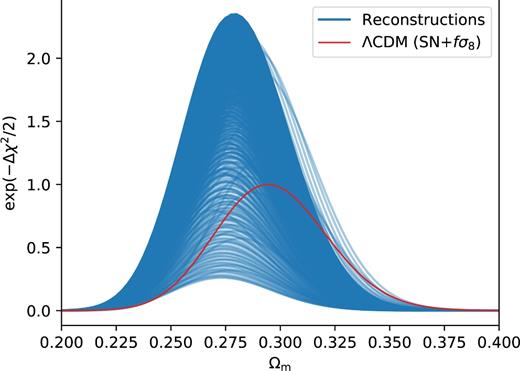
Exp(−Δχ2/2) (with respect to the best-fitting ΛCDM model) versus Ωm for each reconstruction, fixing (γ, σ8) = (0.55, 0.80). The red line shows the ΛCDM case.
We then allow γ or σ8 to vary together with Ωm, while fixing the third parameter to its fiducial value (σ8 = 0.80 or γ = 0.55). In both cases, we calculate χ2 for the ΛCDM case, and find the regions where Δχ2 < 2.3 and Δχ2 < 6.18, corresponding to 1σ and 2σ for 2 degrees of freedom. Fig. 2 shows in red the 1σ and 2σ regions of the ΛCDM case. For each model-independent reconstruction, we then calculate the χ2 of the model-independent case, and find the regions in the (σ8, Ωm) and (γ, Ωm) planes where the reconstructions give a better χ2 than the best-fitting ΛCDM, namely, Δχ2 < 0. Fig. 2 shows in blue the superposition of these regions over all reconstructions in the (Ωm, σ8) (left) and (Ωm, γ) (right) planes. Therefore, if a point (σ8, Ωm) (or (γ, Ωm)) is located in the blue region, there exists at least one reconstruction that, combined with (σ8, Ωm) (or (γ, Ωm)), yields a better χ2 than the best-fitting ΛCDM model.
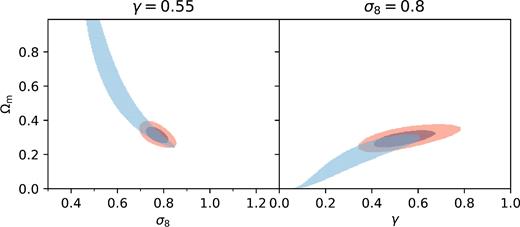
Superposition of the Δχ2 < 0 (with respect to the best-fitting ΛCDM model) regions for γ = 0.55 (left) and σ8 = 0.80 (right) in the model-independent case in blue. We also show in red the 1σ and 2σ regions of the ΛCDM model.
Fixing γ = 0.55 yields higher preferred values for Ωm, while fixing σ8 = 0.80 yields lower preferred values. However, the model-independent approach is fully consistent with ΛCDM. Moreover, it can be seen that, when h(z) is not restricted to ΛCDM, there is a stronger degeneracy in the parameters. Namely, it is possible to find expansions histories that, coupled with low values of Ωm and γ, or with high values of Ωm and σ8, give a better fit to the combined data. The degeneracy in the parameters can be understood from equation (5): for fixed σ8, |$\Omega _{\rm m}^\gamma$| should stay roughly constant, therefore lower Ωm are compensated by lower γ. Similarly, for fixed γ, Ωmσ8 should stay constant, therefore lower Ωm demand higher σ8. This is consistent with the results of Shafieloo et al. (2013), with slightly tighter constraints.
Finally, we vary all three parameters (Ωm, γ, σ8) simultaneously. Fig. 3 shows in red the projections of the Δχ2 < 3.53 and 8.02 regions of the ΛCDM case, corresponding to 1σ and 2σ for 3 degrees of freedom, on to the (σ8, γ) (top-left), (σ8, Ωm) (bottom-left), and (γ, Ωm) (bottom-right). For the model-independent case, we proceed as in Fig. 2, and find the Δχ2 < 0 regions for each reconstruction. We then show in blue the projection on to the three planes of the superposition of the Δχ2 < 0 regions over all reconstruction. Again, the blue region shows the region of the parameter space where there is at least one model-independent reconstruction that yields a better χ2 than the best-fitting ΛCDM model.
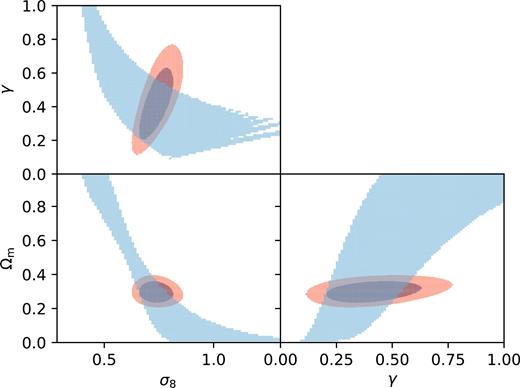
Superposition of the Δχ2 < 0 (with respect to the best-fitting ΛCDM model) regions for (Ωm, γ, σ8) for the model-independent case (blue). In red we show the 1σ and 2σ regions for the ΛCDM case.
The model-independent joint constraints on (Ωm, γ, σ8) are now very broad. They are fully consistent with the ΛCDM model. The Δχ2 < 0 region is consistent with both Ωm = 0 and Ωm = 1, while it allows γ between about 0.1 and 1, and σ8 between 0.25 and 1.25.
4 DARK ENERGY CONSTRAINTS
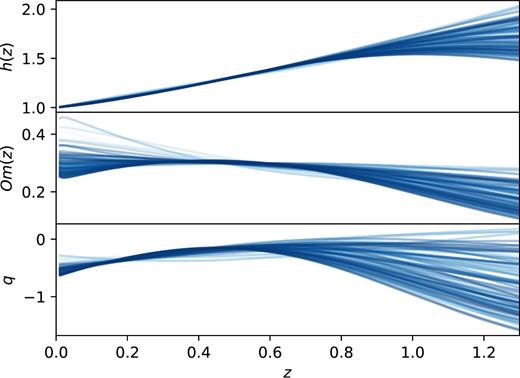
Reconstructed h(z), Om(z), and q(z). The colour code shows the index of the reconstruction.
The top and bottom panels of Fig. 5, respectively, show the matter density Ωm(z) and the equation of state of DE for some combination of (Ωm, h(z)) verifying the positivity condition (14), colour coded by the index of the reconstruction. The expansion histories that are closer from ΛCDM have a Om parameter close to constant, and their q(z) can cross 0, while some reconstructions further from ΛCDM do not cross 0. When Ωm(z) crosses 1, equation (14) ceases to be valid, therefore none of the lines shown here cross 1.
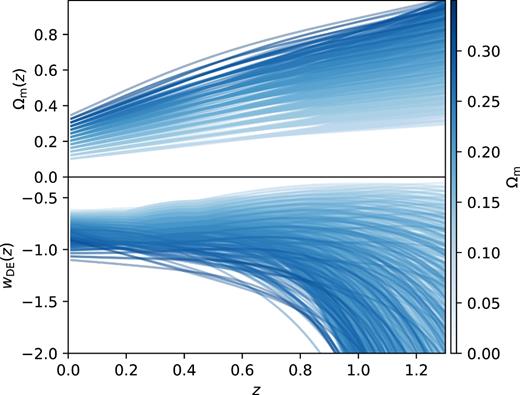
Reconstructed Ωm(z) (top) and w(z) (bottom) for different Ωm and h(z). All lines here verify equation (14).
We can now add the positivity condition (14) as a hard prior on Ωm in the previous analysis. Indeed, large values of Ωm combined with some reconstructions can lead to negative DE density, and these combinations should thus be rejected. Figs 6 and 7 show in blue the superposition over all reconstructions verifying equation (14) of the projected Δχ2 < 0 regions of the parameter space. The red contours are unchanged with respect to Figs 2 and 3.
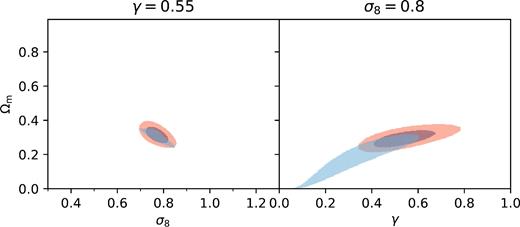
Blue: truncation of the Δχ2 < 0 (with respect to the best-fitting ΛCDM model) regions for γ = 0.55 (left) and σ8 = 0.80 (right) in the model-independent case using equation (14) as a hard prior. Red: 1σ and 2σ regions of the ΛCDM model.
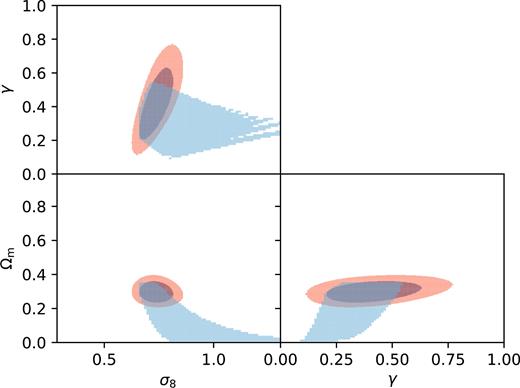
Blue: truncation of the Δχ2 < 0 (with respect to the best-fitting ΛCDM model) regions for (Ωm, γ, σ8) for the model-independent case using equation (14) as a hard prior. Red: 1σ and 2σ regions of the ΛCDM case.
In Fig. 6, while the σ8 = 0.8 case (right-hand panel) is not affected much, since it preferred lower values of Ωm, the allowed region for the γ = 0.55 case is drastically reduced, and only a small space of the original Δχ2 < 0 regions (i.e. before applying equation 14) is allowed. This region is located in the 2σ region of the ΛCDM case.
In Fig. 7, the Δχ2 < 0 regions in each projection are also truncated with respect to Fig. 3, restricting the lower range of σ8 and the higher range of γ and Ωm.
The positivity condition (14) is thus a very strong constraint on the cosmological parameters, since it forbids large values of Ωm ≳ 0.4. Indeed, for these values, the DE density crosses zero within our data range, therefore these values are not allowed here. On the other hand, for low enough values, ΩDE(z) never crosses zero.
5 DISCUSSION AND CONCLUSION
Using model-independent reconstructions of the expansion history from Type Ia supernovae data, we fit the growth data and obtain constraints on (Ωm, γ, σ8). These model-independent constraints on the cosmological parameters are broader than the ΛCDM ones, but fully consistent. When all three cosmological parameter are let free, they are not well constrained, and it is possible to find expansion histories with cosmological parameters that are far from the ΛCDM constraints that give a reasonable fit to the data.
However, when restricting the combinations of Ωm and the reconstructed expansion histories h(z) that yield a positive DE density parameter (h2(z) − Ωm(1 + z)3 > 0), the constraints on the cosmological parameters become stronger. Moreover, when imposing GR, i.e. fixing γ = 0.55, the model-independent contours are truncated and fully contained within the ΛCDM ones, showing strong evidence in favour of ΛCDM. That is, combinations of large Ωm with expansion histories that are too different from ΛCDM are excluded. It should be noted that in Linder (2005), γ depends on w following γ(w) = 0.55 + 0.05w(z = 1), therefore fixing γ = 0.55 is not completely model independent. However, we expect it to have little influence on the results presented here.
Our constraints are more stringent than Shafieloo et al. (2013) thanks to the better quality of the data and the introduction of the DE density positivity condition. The results are consistent with a flat ΛCDM Universe and gravity described by GR, although modified theories of gravity predicting different growth index cannot be ruled out at this stage. The combined χ2 being currently dominated by the supernovae data, better growth measurements are needed to further constrain gravity theory.
Future surveys such as the Dark Energy Spectroscopic Instrument (DESI; DESI Collaboration et al. 2016) will bring down the errors on the growth measurements, while surveys such as the Wide Field Infrared Survey Telescope (WFIRST; Spergel et al. 2015) and the Large Synoptic Survey Telescope (LSST; Ivezic et al. 2008) are expected to observe thousands of supernovae, increasing the quality of the data and covering a larger redshift range.
ACKNOWLEDGEMENTS
We thank Eric Linder for useful discussions, and Teppei Okumura for providing us with the fσ8 data. The computations were performed by using the high performance computing cluster Polaris at the Korea Astronomy and Space Science Institute. AS would like to acknowledge the support of the National Research Foundation of Korea (NRF-2016R1C1B2016478). The authors thank the Yukawa Institute for Theoretical Physics at Kyoto University. Discussions during the CosKASI-ICG-NAOC-YITP joint workshop YITP-T-17-03 were useful to complete this work.
REFERENCES
APPENDIX A: DATA VISUALIZATION
For visualization purpose, Fig. A1 shows some reconstructed fσ8 verifying equation (14) and with |$\chi ^2<\chi ^2_{\rm \Lambda CDM}$|.

fσ8 data and reconstructed fσ8 with free (Ωm, γ, σ8). All lines shown here have |$\chi ^2<\chi ^2_{\rm \Lambda CDM}$|.



